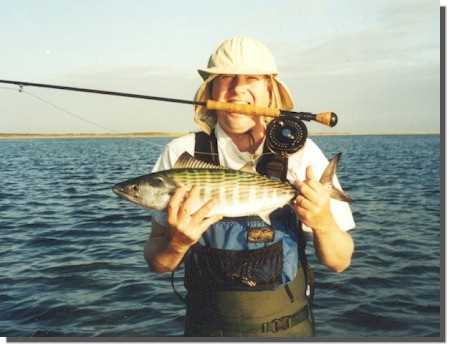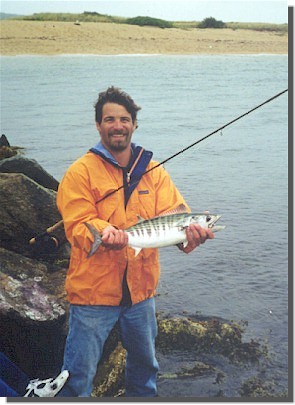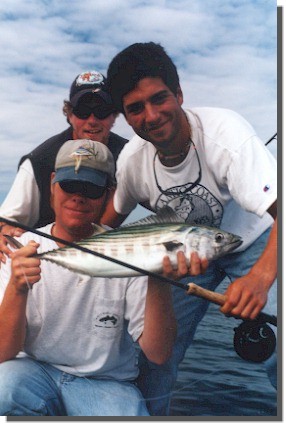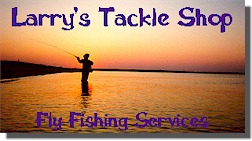FLYROD SHORE BONITO!
Story By Chris Windram

Home | Saltwater Flies | Fly Tying Materials | Saltwater Fly Fishing Accessories
Ordering Instructions, Shipping rates, Your Satisfaction Guaranteed | Site Map

|
Fly rod shore bonito. It's the ultimate quest, the holy grail of northeast saltwater fly fishing. To capture one of these oceanic predators with a fly rod from beach or jetty is a feat worthy of a boast, and each year, only a small handful of fortunate anglers throughout New England will lay claim to these bragging rights. Even more than the false albacore, Sarda sarda, the Atlantic Bonito, is considered by many anglers to be the most difficult of the big four northeast saltwater gamefish (striped bass, bluefish, bonito, and false albacore) to bag from shore, especially with a fly rod. Atlantic Bonito are members of the mackerel family. These torpedo shaped fish are pearlescent on the belly, shading to an iridescent green on the back. Dark horizontal stripes line the back of the fish, making the bonito a dramatically colored and very beautiful fish. Adults average around five or six pounds here in the northeast, and a few specimens approaching ten pounds are caught by anglers in New England each year. Any bonito over ten pounds is a real trophy, and some world-record class fish have come from New England waters, especially the productive waters surrounding Martha's Vineyard and Nantucket. Anglers commonly fish for bonito from shore in many locations between Montauk Point and the southern shore of Cape Cod, but Rhode Island shores and the islands of Massachusetts provide some of the best opportunities to hook up with a flyrod shore bonito. Bonito generally prefer deeper water than the other pelagic inshore gamefish of New England, and are often found offshore where they fall prey to the larger tuna species, as well as sharks and marlin. When bonito come inshore to feed in the summer and fall, they're a bit more skittish than their cousins the false albacore. While it's not uncommon to find albies raiding the flats in no more than two feet of water, bonito seem to prefer water that's at least eight feet deep, and make rushes into shallow water and runs along the beach more sporadically than the false albacore. When they venture into shallow water, they usually won't stay as long unless the feeding conditions are very good, but when they do hit the beach, the action can be fast and furious. 
Bonito appear along the beaches and jetties of New England each year as early as mid-July, and often stay until late October. Shore anglers get some of their best chances to catch these elusive fish during the month of August, when water temperatures and high bait concentrations are conducive to feeding and blitzing behavior. This is bonito prime-time, the season when you are most likely to encounter bones consistently in inshore waters, and anglers who can spend a lot of time on the water during this period will have the best chances for success. Bonito will also feed heavily as water temperatures begin to drop at the end of the season, but in general the late summer months provide the best opportunities for shore-bound flyrodders. Bonito prey on a variety of baitfish as well as squid and crustaceans. Atlantic Mackerel and Butterfish are favored prey items, and these tasty morsels are used very effectively as bait by anglers fishing from docks, jetties, and boats. When bonito blitz the beach or jetties, however, it's a good possibility that they're feeding on one of three small baitfish; Menidia menidia, the Atlantic Silversides; Anchoa mitchilli, the Bay Anchovy; or Ammodytes americanus, the American Sand Lance, commonly known as the sand eel. This tendency to feed heavily on these small baitfish puts the bonito within reach of tideline fly rodders all over New England. For flies, consider the following patterns as standards: white bunny flies, commonly called bonito bunnies, small, sparse white deceivers, and epoxy flies tied to imitate the silversides, sand eels, and bay anchovies that bonito feed heavily upon. Choose white or olive and white flies when fish are feeding on silversides, a tan and white or gold colored fly when fish feed on bay anchovies, and chartreuse or olive and white when fish are feeding on sand eels. Clouser minnows will work at times, and can help get below the bait where the fish can see your fly. Match your fly closely to the available baitfish, and you'll improve your chances for hooking up with bonito. Proper tackle for fly fishing for bonito from shore starts with a good rod, and a nine weight is a good choice to cover a variety of conditions. Such a rod is light enough to cast all day, and heavy enough to play fish effectively from beach or jetty. A sturdy reel with a smooth drag will be important, especially if you hook into a big fish. Two hundred yards of backing should give you enough line to play almost any bonito that you tangle with. Good fly lines for shore bonito include an intermediate line that you are comfortable with (the clear intermediates are very popular with hardcore bonito and albie addicts), and you also might wish to carry a medium density sinking line in the 250-350 grain range for those times when you need to get the fly down a bit more. Leaders should be about eight feet long, and should end in a fifteen pound test tippet. Many anglers fish a lighter tippet believing that the fish are leader shy, but break-offs can easily occur on the hookset or while playing the fish with lighter tippets. If you are concerned about leader visibility, choose one of the modern fluorocarbon leaders that are widely available in good tackle and fly shops. Although bonito have teeth, these teeth are conical with no cutting edges and it is rare to get cut off by the fish's teeth. Break-offs are another matter - usually due to pilot error! Having the right tackle and keeping it in good repair will increase the likelihood that you'll be prepared to make good presentations to fish, as well as to effectively play any fish that you hook up with. The point has been stated often and emphatically that time on the water is your surest ticket to learning how to be a successful saltwater fly rodder, and it's true for bonito fishing as well. The more time that you can spend in the areas that bonito frequent, the better equipped you'll be to catch these speedsters. Being on the water more means that you'll be better prepared for action when the fish arrive. You'll learn more, see more, and you'll simply have a better chance of being in the right place at the right time. Savvy anglers know that bonito feed best in the morning hours. If you've got bonito fever, get out on the water early. I try to get to the spots that I want to fish before first light, and I usually find other bonito fanatics already in place when I arrive. Getting out on the water more will give you the best chances to learn as much as possible about fly fishing for bonito, and getting there early will provide you with the best chances at consistently finding shoreline bonito action. Some of the best places to find and catch bonito (and other saltwater gamefish) with a flyrod are inlets. Most inlets have plenty of water movement, structure, and often harbor the quantities of baitfish that bonito seek. Inlets with jetties provide anglers with convenient perches for fishing from the rocks, and natural inlets are comfortable places to fish for bonito as well. Other good spots are beaches with good water movement and relatively deep water not far offshore, and points of land that create rips that form during the flow of the tide. Pay attention to other anglers if you want to find the hot spots - good spots for bonito fishing are rarely secret. Finding a few key spots and fishing them regularly is probably better than fishing four different spots on four different mornings. If you can pick one spot where fish have been showing regularly and stay there, you'll have a much better chance of being right in the strike zone when the fish arrive. While you're on the water, keep a keen eye out towards learning bonito behavior. When bonito feed in a given area, they often show a pattern of movement. Learning to recognize the feeding patterns of these fish will allow you to intercept bonito as they blitz through an area. Fish may commonly hit the beach or shoreline at the same point, then move along the beach or jetty in one direction before moving away from the structure to begin the pattern all over again. On occasion, bonito will hit the shoreline, then move in either direction at random, but this is most likely to occur only when the feeding is very good and prey densities are high. Like most fish, bonito prefer to feed into the tide or prevailing currents whenever possible. Incoming water at an inlet can bring fish right inside the inlet within easy reach of shore flyrodders. Outgoing water often puts fish just outside the inlet, but feeding heavily on the bait that gets washed out at this stage of the tide. Once you have a good understanding of how the fish move in your area, position yourself to intercept the movements of the fish. When you see fish approaching your position, be ready to place the fly directly in the path of a moving school, or cast directly into the schools of breaking fish. Keep the fly in the water as much as possible during the time that the fish come through. If you don't hook up, you may feel compelled to chase the fish down the beach, but this can be counter-productive, as it's almost impossible to catch up to a school of fast running bonito. Stay put, and have faith that the fish will come your way again. It's also not a bad idea to keep casting after the fish have gone down. It is not at all unusual to have bonito come up and hit the fly even after they've stopped blitzing. In the long run, waiting for the fish and keeping the fly in the water will pay off. Find the patterns and preferences of the fish in your area, and you'll be on the way to meeting the challenge of hooking up with a shore flyrod bonito.When you get a strike, set the hook hard. Bonito tend to bite down hard on the fly and run with it, preventing a positive hook-set, but giving the angler the impression that the fish is solidly hooked, even when this is not the case. Often a fish will run off forty or fifty yards, open its mouth, and then drop the fly. Vineyard angler Ken VanDerlaske had this tip to offer: when the fish begins to run after your hookset, apply some light pressure on the line with your fingers as the fish runs - this may help turn the hook into the corner of the mouth where it can penetrate. If you plan on fishing flies tied on circle hooks, which are becoming more popular for bonito and albacore fishing, don't make an initial hookset, but apply this same light pressure as the fish begins to run. By the time the fish has run out to the backing, the hook should be firmly lodged in the corner of the mouth. After you've got the hook well set in the fish's mouth, you're ready to fight the fish effectively. 
Atlantic Bonito are strong fish that make lightning fast runs and sudden changes in direction. I've witnessed the look of disappointment on more than one angler's face when he or she felt the line go slack as a fish turned and ran straight at them, only to see an expression of joy return as the hooked fish turned out and ran strongly away from them again. Successful anglers will stay focused while the fish is on the line, reeling up fast when bonito create slack, making sure that the reel runs smoothly when fish are taking line. Though bonito are every bit as fast as their cousins the false albacore, they don't have quite as much staying power, and may run out of steam sooner. This doesn't mean that putting one on the rocks is easy, however, as these fish fight hard to the last, and often circle doggedly at the end of the battle. When you've got a bonito close, try to keep the fish's head up until it can be netted or tailed by yourself or a friend. Be patient and careful with the fish at this point, but keep the pressure on. A successful release of a bonito from shore is a great triumph for any New England saltwater fly rodder. Occasionally, bonito will fight to the death, especially if an angler takes too much time with the fish, so try to play the fish skillfully. Handle the fish as little as possible, remove the hook quickly, and keep the fish in the water or return it to the water as soon as possible after capture to ensure a successful release. Watching such a magnificent creature swim strongly away will be a rewarding experience. Bonito are fast, beautiful swimmers with a flair for unpredictability. Learn to match the baitfish, get your tackle in order and get some time on the water, pay attention to the movements of the fish, and then hone your fish-playing skills if you want to be successful landing flyrod bonito. If you have a tough day chasing the fish as all shore bonito fishermen will, remember that it is the thrill of the chase that keeps us coming back. Be persistent and be patient, and you too will experience the excitement of landing a flyrod shore bonito. Notes on cooking bonito: Although catch and release should be encouraged whenever possible in these days of heavy fishing pressure and less than perfect fisheries management, it certainly won't hurt to keep a fish or two each season if you should be fortunate enough to catch some. Bonito make excellent eating when properly prepared. If you wish to keep a fish for the table, be sure to bleed the fish quickly, get it on ice, then take it home and enjoy a real treat with your friends and family. Don't forget to release most of the fish that you catch to ensure that we'll all enjoy good fishing for these spectacular fish for years to come. Grilled Bonito: One 4-8 pound bonito (or bigger if you can catch one!). One clean grill, good and hot. Fillet and skin the bonito. Bonito have a row of large bones running down the center of the fillet - I cut around these, essentially quartering the fish. You'll end up with what look like tenderloins - similar to what bluefin cuts look like in the fish market, although on a miniature scale. Once you've got your tenderloins, you're ready to grill. Brush the hot grill surface with olive oil, and rub the fish with the oil as well. Season the fish well with a bit of sea salt. Place the fish on the grill, searing the meat. Turn and mark each side of your tenderloins on the hot grill. By the time each side has been well marked, the bonito should be done. I like to cook bonito medium rare, like any good tuna steak. There are plenty of folks who like to enjoy a little appetizer of sashimi (raw bonito) served with wasabi and soy sauce, but if you wish to do this be sure to check the fish for any visible parasites in the flesh (I have never found any in the bonito that I've caught), and be sure that the fish is absolutely fresh and has been kept on ice if you plan to enjoy it raw. Serve your fish with a bit of minted cous cous, or perhaps some steamed tender young potatoes along with a vegetable medley of baby zucchini and yellow squash. A chilled glass of white wine, a cold beer, some good friends, and you're on your way to celebrating one of life's true pleasures; the satisfaction of harvesting one of New England's most elusive fly rod gamefish: The Atlantic Bonito. More Articles & PhotosThe following fly and tackle shops can provide interested anglers with more information for folks wishing to go bonito fishing, including accommodations, local fishing spots, and the timing of the runs, as well as bookings for fly fishing guides: 
Larry's Tackle Shop TIGHT LINES! SaltwaterFlies.com - Got Backing? |
E-mail us with tales of your own at cwindram@SaltwaterFlies.Com!